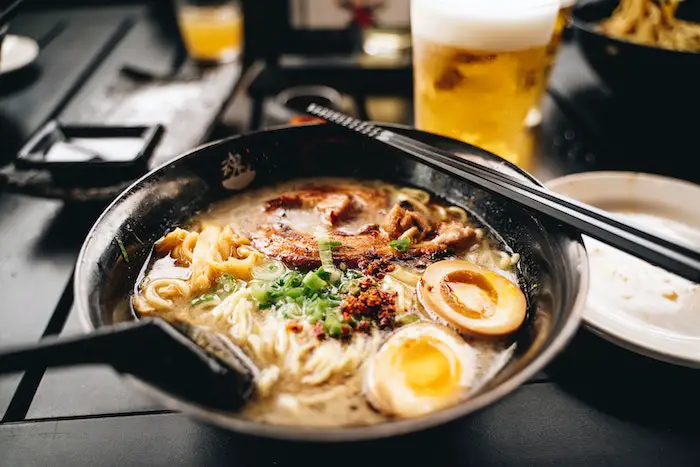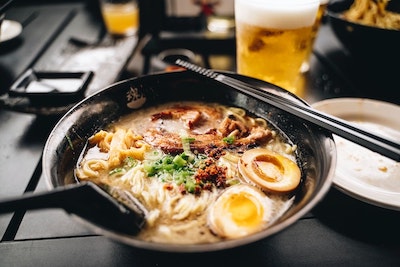We are reader supported. When you purchase through links on our site, we may earn an affiliate commission. Also, as an Amazon affiliate, we earn from qualifying purchases.

If you are a ramen lover and someone asks you what makes it a favorite, you will probably say it’s due to the umami flavor without even batting an eye. Have you ever wondered what gives that unique umami flavor to your much-loved delicacy, though?
Many people have wondered about this question: do ramen shops in Japan use MSG? The answer is yes in almost all cases. Most of the ramen shops in Japan add small amounts of MSG as an ingredient to their soups, so MSG may either be added as one would simply do with any other seasoning, or it may come from the seaweed or other MSG-containing ingredients used to make the broth.
Now, let’s dig a little deeper into the topic.
Umami has secured its place as among the basic tastes we experience each day when consuming our food, drinks, and other items, letting it hold its own against our usual flavors of sweet, sour, salty, and bitter. In Japan, the birth and evolution of ramen led to the discovery of umami which soon became deeply attached to the food-related culture of the country.
One basic Umami example is what’s referred to as Dashi, which is a standard soup stock in Japan that consists of glutamic acid-rich kelp and inosinic acid-rich dried bonito as two of its main components. Most of the ramen shops out there use some amount of MSG to lend that umami flavor to their dishes.
The main reason behind this usage of MSG is to make up for any discrepancy in the taste caused by the quality of the ingredients used. The taste of soups does not stay consistent due to variations in ingredients. This lack of consistency is compensated for by shop owners by adding some amount of MSG to the dishes.
Thus, umami and ramen have a close association with each other due to their connection via food additives substances like monosodium glutamate (MSG).
Contents
The True Definition of MSG
For those who are curious, let’s take a look at what Wikipedia has to say about monosodium glutamate, also known and referred to as sodium glutamate or MSG. As per the website, MSG is the “sodium salt of glutamic acid” and is a non-essential amino acid that can be both naturally occurring as glutamic acid in certain foods as well as became its own isolated entity due to a chemist named Kikunae Ikeda.
In the US, it is classified by the FDA as “generally recognized as safe” (GRAS), and the European Union simply just labels it as a food additive. The industrial food manufacturers’ market also uses MSG as a potential flavor enhancer because it blends and balances the perception of other tastes.
Although MSG is used to enhance a dish’s taste, you will be surprised to learn that it does not have much taste itself. However, when this substance is added to other foods, it enhances the flavor several times over.
MSG and Toxicity Levels
In some ramen shops, you may come across some delicious food that has been created by simply adding far too much MSG to a broth or soup that has otherwise been made for a lower production price due to its low-quality ingredients. As per WHO, or the World Health Organization, they have backed the notion that consuming MSG poses no health threats or concerns in most individuals and is, therefore, safe to continue using.
Thus, shops proceed in still adding this substance to soups to make them delicious regardless of the ingredients and nutrition. It has now become a common practice to include food additives to enhance the taste of certain foods, and it’s no wonder as this has made many of our lives much easier.
The only downside reported by some people is that once their tongue gets accustomed to the unique flavor, taste, and sensations produced by these additives, they are no longer able to enjoy everyday food. The regular food made from natural ingredients appears bland to them.
Instinctively, we only crave the most delicious kinds of food, so that’s generally what we’ll always want to gravitate towards consuming. Artificial ingredients such as monosodium glutamate are capable of tricking our mouths and taste buds into making us consume more of these additive-loaded foods than is truly necessary in a lot of these cases, especially when the flavor seems so much better than any other options. There is also the possibility that additives such as these may contribute to throwing off our senses when it comes to meals and alter our preferences and overall diets.
Arguments in Favor Of MSG

The Japanese are absolutely in love with their noodle soup and to a large extent, even sentimental about it. There are many popular ramen chefs who are TV celebrities, and Japan broadcasts more cooking shows than anywhere else in the world. This food-obsessed country also has an extensive variety of street food, too.
In Japan, though, they are happy with the kind of effect that monosodium glutamate has on their ramen. MSG is cheap and readily available in the country, and people simply like the taste. What else could they ask for when this additive so easily meets their needs? The locals have no fear of MSG.
If MSG is actually bad for one’s health or is toxic, as the popular American Vogue food writer Jeffrey Steingarten put it, then everyone in Japan should have a headache all of the time, right?
MSG Manufacturers’ Take on the Matter
While there is one side of the food industry that is cynical about MSG, there are others who are more busy promoting it instead. Many people think monosodium glutamate is made from chemicals, so therefore it may be unhealthy. However, water also has a chemical formula, and it can’t be considered unhealthy just due to it having chemical composition as well, correct?
MSG manufacturers have been constantly promoting it as a useful product and as a means to consume less salt. They have even tried involving celebrities in promoting or doing PR for MSG. Heston Blumenthal, a popular British chef, has promoted the umami culture at several conferences across the world and has become known for his association with promoting additives to contribute to such flavors.
The Popularity of MSG in America
In America, MSG arrived at a perfect time when the mass production of processed food was in a booming stage. Despite the popularity of canning, freezing, and pre-cooking food, there was a common problem that existed among these methods: a loss of flavor.
To combat this problem, MSG was considered as a cheap and simple additive that could enhance the taste of everything, even canned food. Due to this problem-solving trait regarding processed American foods, it was then included in nearly everything from canned soups to processed meats, salad dressings, ice cream, bread, carbohydrate-based snacks, canned tuna, chewing gum, and more.
The use and popularity of MSG grew as the industry also progressed. It even became utilized in chilled, frozen, and dehydrated “ready meals,” too. MSG also became a crucial ingredient in low-fat and no-fat foods, where the flavors are lacking due to the extraction of oils.
Other Things That Contain MSG
It’s not just ramen that contains this chemical substance; there are also some other food items too that are known to contain MSG. Some examples are chicken or beef flavorings, plant proteins, hydrolyzed milk, textured proteins, soy sauce, seasonings, and other broths and spices.
In these products, though, you may find MSG listed under various other names such as glutamic acid, calcium caseinate, sodium caseinate, autolyzed yeast extract, glutamine, monopotassium glutamate, and gourmet powder.
There are also a few substances that are not exactly MSG, but they are nearly the same thing and function similarly. Examples of these are yeast extract, Ajinomoto, natrium glutamate, autolyzed yeast, glutamic acid, calcium glutamate, and anything else labeled as “hydrolyzed.”
Related questions
Does instant ramen have MSG?
Yes. Most of the instant ramen noodles available in stores today have MSG in them, but in most cases, this is not mentioned on the packaging or in the list of ingredients.
Does ramen have gluten?
Yes, of course. Ramen noodles are full of gluten as their main ingredient is wheat flour. The broth that goes with these noodles often contains a soy sauce base too, which may be a problem for those who wish to follow a gluten-free diet.
How can you tell if food has MSG in it?
Many food manufacturers declare the use of MSG by its additive code or simply by including its name on the packaging. You can check the ingredient list to see if they mention the inclusion of MSG itself or the ingredient known as “flavor enhancer 621.”
See Also:
Is Japanese Ramen Healthy (Explained)
13 Street Foods in Japan
Can You Eat Ramen Raw? Read This First!
How to Eat Udon? Read This First!

